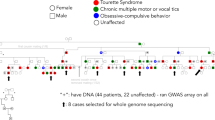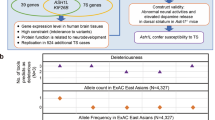Abstract
Tourette syndrome (TS) is a genetically complex disorder for which no causative genes have been unequivocally identified. Nevertheless, a number of molecular genetic studies have investigated several candidate genes, particularly those implicated in dopamine modulation. The results of these studies were inconclusive, which may be due, at least in part, to the variable ethnicity of the patients included in different studies and the chosen research design. In this study, we used a family-based association approach to investigate the implication of dopamine-related candidate genes, which had been previously reported as possibly associated with TS [genes that encode for the dopamine receptors DRD2, DRD3 and DRD4, the dopamine transporter 1 (SLC6A3) and the monoamine oxidase-A (MAO-A). The studied group was composed of 110 TS patients. These patients were selected from the French Canadian population, which displays a founder effect. Excess transmission of the 7-repeat allele of the DRD4 exon-3 VNTR polymorphism (χ2 TDT =4.93, 1 df, P=0.026) and the putative ‘high-activity’ alleles of the MAO-A promoter VNTR polymorphism (χ2 TDT =7.124, 1 df P=0.0076) were observed. These results were confirmed in a subgroup of patients with no attention deficit/hyperactivity or obsessive compulsive comorbid disorders. Haplotype analysis using one or two supplemental polymorphism in each of these genes confirmed these associations and allowed one to identify risk haplotypes. No associations were found for DRD2, DRD3 or SLC6A3. These data support the notion that DRD4 and MOA-A genes may confer an increased risk for developing TS in the French Canadian population.
This is a preview of subscription content, access via your institution
Access options
Subscribe to this journal
Receive 12 print issues and online access
$259.00 per year
only $21.58 per issue
Buy this article
- Purchase on Springer Link
- Instant access to full article PDF
Prices may be subject to local taxes which are calculated during checkout
Similar content being viewed by others
References
Faridi K, Suchowersky O. Gilles de la Tourette's syndrome. Can J Neurol Sci 2003; 30(Suppl 1): S64–S71.
Friel PB . Familial incidence of Gilles de la Tourette's disease, with observations on aetiology and treatment. Br J Psychiatry 1973; 122: 655–658.
Walkup JT, La Buda MC, Singer HS, Brown J, Riddle MA and Hurko O . Family study and segregation analysis of Tourette syndrome: evidence for a mixed model of inheritance. Am J Hum Genet 1996; 59: 684–693.
Price RA, Kidd KK, Cohen DJ, Pauls DL, Leckman JF . A twin study of Tourette syndrome. . Arch Gen Psychiatry 1985; 42: 815–820.
Pauls DL . Update on the genetics of Tourette syndrome. Adv Neurol 2001; 85: 281–293.
Spielman RS, McGinnis RE, Ewens WJ . Transmission test for linkage disequilibrium: the insulin gene region and insulin-dependent diabetes mellitus (IDDM). Am J Hum Genet 1993; 52: 506–516.
Sham PC, Curtis D . An extended transmission/disequilibrium test (TDT) for multi-allele marker loci. Ann Hum Genet 1995; 59(Part 3): 323–336.
Brais B, Bouchard JP, Xie YG, Rochefort DL, Chretien N, Tome FM, et al. Short GCG expansions in the PABP2 gene cause oculopharyngeal muscular dystrophy. Nat Genet 1998; 18: 164–167.
Chumakov I, Blumenfeld M, Guerassimenko O, Cavarec L, Palicio M, Abderrahim H, et al. Genetic and physiological data implicating the new human gene G72 and the gene for D-amino acid oxidase in schizophrenia. Proc Natl Acad Sci USA 2002; 99: 13675–13680.
Lavenstein BL . Treatment approaches for children with Tourette's syndrome. Curr Neurol Neurosci Rep 2003; 3: 143–148.
Peterson BS, Thomas P, Kane MJ, Scahill L, Zhang H, Bronen R, et al. Basal ganglia volumes in patients with gilles de la tourette syndrome. Arch Gen Psychiatry 2003; 60: 415–424.
Peterson BS . Neuroimaging studies of Tourette syndrome: a decade of progress. Adv Neurol 2001; 85: 179–196.
The Tourette Syndrome Classification Study Group. Definitions and classification of tic disorders. Arch Neurol 1993; 50: 1013–1016.
Freeman RD, Fast DK, Kent M . DSM-IV criteria for Tourette's. J Am Acad Child Adolesc Psychiatry 1995; 34: 400–401.
Leckman JF, Riddle MA, Hardin MT, Ort SI, Swartz KL, Stevenson J, et al. The Yale Global Tic Severity Scale: initial testing of a clinician-rated scale of tic severity. J Am Acad Child Adolesc Psychiatry 1989; 28: 566–573.
Goodman WK, Price LH, Rasmussen SA, Mazure C, Fleischmann RL, Hill CL, et al. The Yale-Brown Obsessive Compulsive Scale. I. Development, use, and reliability. Arch Gen Psychiatry 1989; 46: 1006–1011.
Conners CK . A teacher rating scale for use in drug studies with children. Am J Psychiatry 1969; 126: 884–888.
Vandenbergh DJ, Persico AM, Hawkins AL, Griffin CA, Li X, Jabs EW, et al. Human dopamine transporter gene (DAT1) maps to chromosome 5p 15.3 and displays a VNTR. Genomics 1992; 14: 1104–1106.
Grandy DK, Zhang Y, Civelli O . PCR detection of the TaqA RFLP at the DRD2 locus. Hum Mol Genet 1993; 2: 2197.
Joober R, Toulouse A, Benkelfast C, Lal S, Bloom D, Labelle A, et al. DRD3 and DAT1 genes in schizophrenia: an association study. J Psychiatr Res 2000; 34: 285–291.
Lichter JB, Barr CL, Kennedy JL, Van Tol HH, Kidd KK and Livak KJ . A hypervariable segment in the human dopamine receptor D4 (DRD4) gene. Hum Mol Genet 1993; 2: 767–773.
Grice DE, Leckman JF, Pauls DL, Kurlan R, Kidd KK, Pakstis AJ, et al. Linkage disequilibrium between an allele at the dopamine D4 receptor locus and Tourette syndrome, by the transmission-disequilibrium test. Am J Hum Genet 1996; 59: 644–652.
Seaman MI, Fisher JB, Chang F, Kidd KK . Tandem duplication polymorphism upstream of the dopamine D4 receptor gene (DRD4). Am J Med Genet 1999; 88: 705–709.
Sabol SZ, Hu S, Hamer D . A functional polymorphism in the monoamine oxidase A gene promoter. Hum Genet 1998; 103: 273–279.
Hotamisligil GS, Breakefield XO . Human monoamine oxidase A gene determines levels of enzyme activity. Am J Hum Genet 1991; 49: 383–392.
Cases O, Seif I, Grimsby J, Gaspar P, Chen K, Pournin S, et al. Aggressive behavior and altered amounts of brain serotonin and norepinephrine in mice lacking MAOA. Science 1995; 268: 1763–1766.
Gilad Y, Rosenberg S, Przeworski M, Lancet D, Skorecki K . Evidence for positive selection and population structure at the human MAO-A gene. Proc Natl Acad Sci USA 2002; 99: 862–867.
Shapiro AK, Baron M, Shapiro E, Levitt M . Enzyme activity in Tourette's syndrome. Arch Neurol 1984; 41: 282–285.
Comings DE, Comings BG . Evidence for an X-linked modifier gene affecting the expression of Tourette syndrome and its relevance to the increased frequency of speech, cognitive, and behavioral disorders in males. Proc Natl Acad Sci USA 1986; 83: 2551–2555.
Comings DE, Muhleman D, Dietz G, Dino M, Le Gro R, and Gade R . Association between Tourette's syndrome and homozygosity at the dopamine D3 receptor gene. Lancet 1993; 341: 906.
Gelernter J et al. Gilles de la Tourette syndrome is not linked to D2-dopamine receptor. Arch Gen Psychiatry 1990; 47: 1073–1077.
Devor EJ, Grandy DK, Civelli O, Litt M, Burgess AK, Isenberg KE . Genetic linkage is excluded for the D2-dopamine receptor lambda HD2G1 and flanking loci on chromosome 11q22–q23 in Tourette syndrome. Hum Hered 1990; 40: 105–108.
Rowe DC, Stever C, Gard JM, Cleveland HH, Sanders ML, Abramowitz A, et al. The relation of the dopamine transporter gene (DAT1) to symptoms of internalizing disorders in children. Behav Genet 1998; 28: 215–225.
Comings DE, Wu S, Chiv C, Ring RH, Gade R, Ahn C, et al. Polygenic inheritance of Tourette syndrome, stuttering, attention deficit hyperactivity, conduct, and oppositional defiant disorder: the additive and subtractive effect of the three dopaminergic genes—DRD2, D beta H, and DAT1. Am J Med Genet 1996; 67: 264–288.
Gade R, Muhleman D, Blake H, MacMurray J, Johnson P, Verde R, et al. Correlation of length of VNTR alleles at the X-linked MAO-A gene and phenotypic effect in Tourette syndrome and drug abuse. Mol Psychiatry 1998; 3: 50–60.
Acknowledgements
We thank all the families who participated in this study, Sylvie Toupin and the members of the Montreal Tourette Syndrome Group for all the work and organization of the TS clinic meetings. This work was supported by The Tourette Syndrome Association. ADA is funded by the Mexican National Council for Science and Technology (CONACyT).
Author information
Authors and Affiliations
Consortia
Corresponding author
Rights and permissions
About this article
Cite this article
Díaz-Anzaldúa, A., Joober, R., Rivière, JB. et al. Tourette syndrome and dopaminergic genes: a family-based association study in the French Canadian founder population. Mol Psychiatry 9, 272–277 (2004). https://doi.org/10.1038/sj.mp.4001411
Received:
Revised:
Accepted:
Published:
Issue Date:
DOI: https://doi.org/10.1038/sj.mp.4001411
Keywords
This article is cited by
-
Investigation of previously implicated genetic variants in chronic tic disorders: a transmission disequilibrium test approach
European Archives of Psychiatry and Clinical Neuroscience (2018)
-
Tourette Syndrome and Comorbid Neuropsychiatric Conditions
Current Developmental Disorders Reports (2016)
-
The Genetics of Gilles de la Tourette Syndrome: a Common Aetiological Basis with Comorbid Disorders?
Current Behavioral Neuroscience Reports (2016)
-
Tourette syndrome and comorbid ADHD: causes and consequences
European Journal of Pediatrics (2015)
-
Reward circuitry dysfunction in psychiatric and neurodevelopmental disorders and genetic syndromes: animal models and clinical findings
Journal of Neurodevelopmental Disorders (2012)



